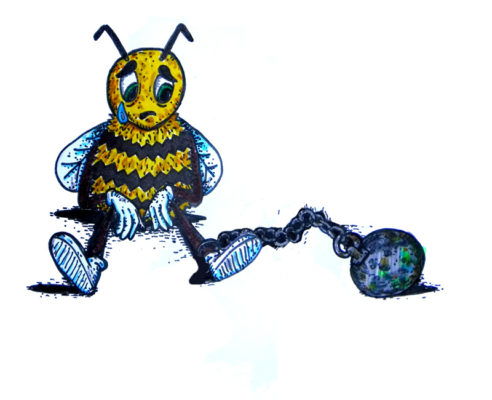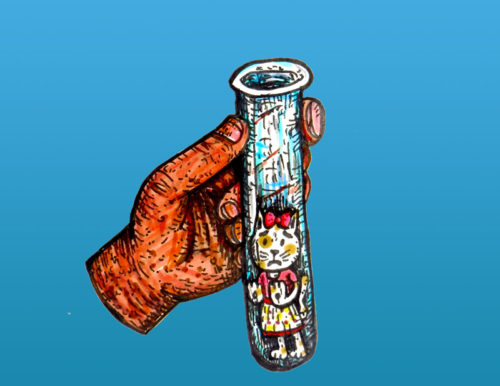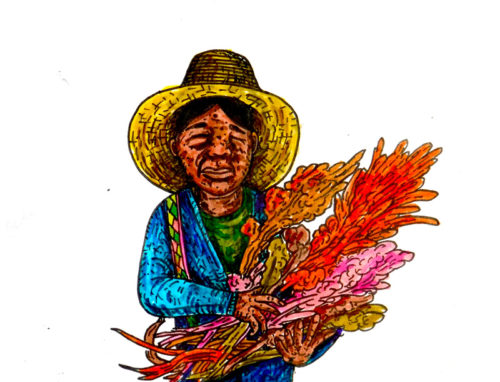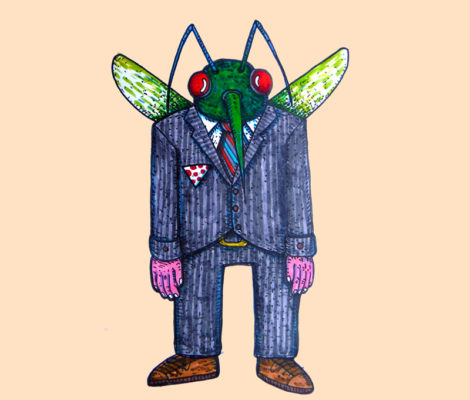Here are five new gene drive organisms that various forces are planning to release into the wild in the near future:
 “Bee Subordinate”
“Bee Subordinate”
Species: Apis mellifera, Apis cerana indica
Developed by: Elwha LLC
Status: Patent filed; technology theoretical
Hype claim: Wild bees engineered to only
pollinate fields that emit a certain light
Reality: Corporate power over agricultural
pollination
A US company has filed a patent for genetically modifying the most common honey bees, proposing to install engineered ‘optogenetic’ genes into the honey bee population.[1]
These would theoretically be switched on and off by an external light beam, influencing which fields they pollinate.
Will a genetic tractor bee-m actually change which fields bees pollinate? Bee experts are skeptical [2].
[1] Maxim, L., & van der Sluijs, J. (2013). Seed-dressing systemic insecticides and honeybees. In European Environment Agency. Late lessons from early warnings: science, precaution, innovation. European Environment Agency, Copenhagen.
[2] Patent: US2016/0310754A1
 “No More Minnie”
“No More Minnie”
Species: Mus, Rattus
Developed by: GBIRD Project, DARPA, Roslin Institute UK
Status: Active research
Hype claim: Eliminate invasive rodents, save endangered birds on islands
Reality: May be applied in agribusiness and spread to wild populations
Rodents cause losses for large-scale agricultural operations estimated in the tens of billions. One proposed solution is to eradicate them using “X-shredder” technology – so named because it disables x chromosomes, resulting in all-male offspring.[3]
Meanwhile the GBIRd project (Genetic Biocontrol of Invasive Rodents), also proposes using “daughterless” gene drive organisms to remove rodents from islands by genetic targeting. However, GBIRd is mainly funded by the US Department of Defense, so when it comes to disappearing Minnie Mouse, there may be more than meets the eye.[4]
[3] McFarlane, G. R., Whitelaw, C. B. A., Lillico, S. G. (2018). CRISPR-Based Gene Drives for Pest Control. Trends in biotechnology, 36(2), 130-133.
[4] Esvelt, Kevin M, Andrea L Smidler, Flaminia Catteruccia, and George M Church. ‘Concerning RNA-Guided Gene Drives for the Alteration of Wild Populations.’ ELife 3. Accessed June 20, 2018. https://doi.org/10.7554/eLife.03401.
 “Goodbye Kitty”
“Goodbye Kitty”
Species: Felis Catus
Developed by: Australian Wildlife Conservancy, CSIRO
Status: Theoretical
Hype claim: “Male only” gene drive cat will wipe out feral cats, protect birds
Reality: May spread into domestic and endangered cat species
Cats down under are in the crosshairs of gene drive extinction technology. A billionaire banker is funding Australian scientists to produce a “goodbye kitty” gene drive. They hope to release a gene-drive cat to mate with feral cats. Theoretically, the offspring would all be male, eventually reducing feral cat numbers–and attacks on birds. If the drive works, it will likely will cross over to domestic cat populations. If Australian cats reach other continents, they may endanger wild cat populations. Almost no genetically engineered mammals have been released into the wild, so a “goodbye kitty” gene drive would cross many risky new frontiers.[5]
[5] See: https://www.theaustralian.com.au/news/health-science/csiro-investigates-gene-war-strategy-to-rub-out-feral-cats/news-story/a44c4cb00385d11d4afc52c48b296a82
 “Adios Amaranth”
“Adios Amaranth”
Species: Amaranthus palmeri
Proposed by: Kevin Esvelt
Status: Theoretical
Hype claim: Make pigweed more vulnerable to glyphosate herbicide
Reality: Could spread to wild and domestic varieties of Amaranth, an important Indigenous food crop
As weeds become more resistant to the chemicals used to kill them, agribusiness giants are seeing a decline in value. For example, Bayer-Monsanto’s roundup (glyphosate) is less and less effective against pigweed (aka Palmer Amaranth).[6]
According to one report, the company could use gene drives to “re-sensitize” pigweed to Roundup. Among other effects, such a move could result in permanent changes to the genetic code of other kinds of Amaranth, which are an important crop for central american Indigenous nations.[7]
[6] Esvelt, Kevin M., Andrea L. Smidler, Flaminia Catteruccia, and George M. Church. ‘Emerging Technology: Concerning RNA-Guided Gene Drives for the Alteration of Wild Populations.’ ELife 3 (July 17, 2014): e03401. https://doi.org/10.7554/eLife.03401.
[7] See: http://nas-sites.org/gene-drives/
 “PR Buzz Mosquito”
“PR Buzz Mosquito”
Species: Aedes aegypti, Anopheles gambiae
Developed by: Target Malaria, DARPA, UC Riverside, UC San Diego
Status: Active research
Hype claim: Eliminate diseases by killing off the mosquitoes that spread them
Reality: Likely won’t work; covers up the real story of gene drives
Just as GMO crops used golden rice as a humanitarian smokescreen, gene drive organisms have mosquitoes. The idea is simple: use gene drives to prevent malaria-carrying mosquitoes from producing female offspring, or change them to be repelled by human scent. Changing entire species in the wild using genetic technology that we don’t yet understand could have many unintended consequences and probably won’t eliminate malaria, but the most dangerous effect could be clearing the way for other gene drive applications. In this respect, the US Military’s $100 million investment in extinction technologies is cause for concern.[8]
[8] See: gene drive files: www.genedrivefiles.synbiowatch.org